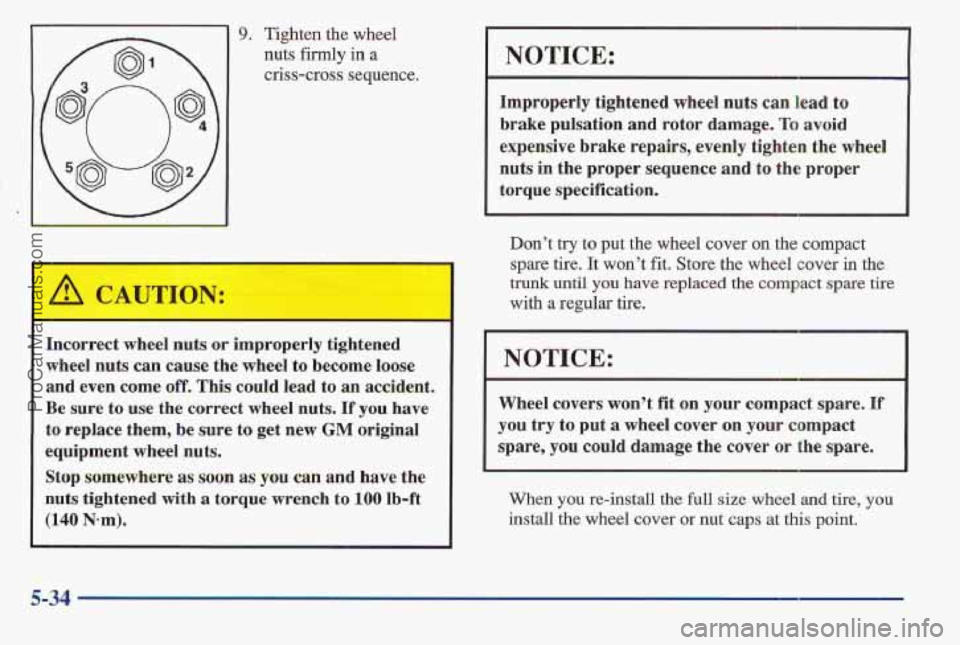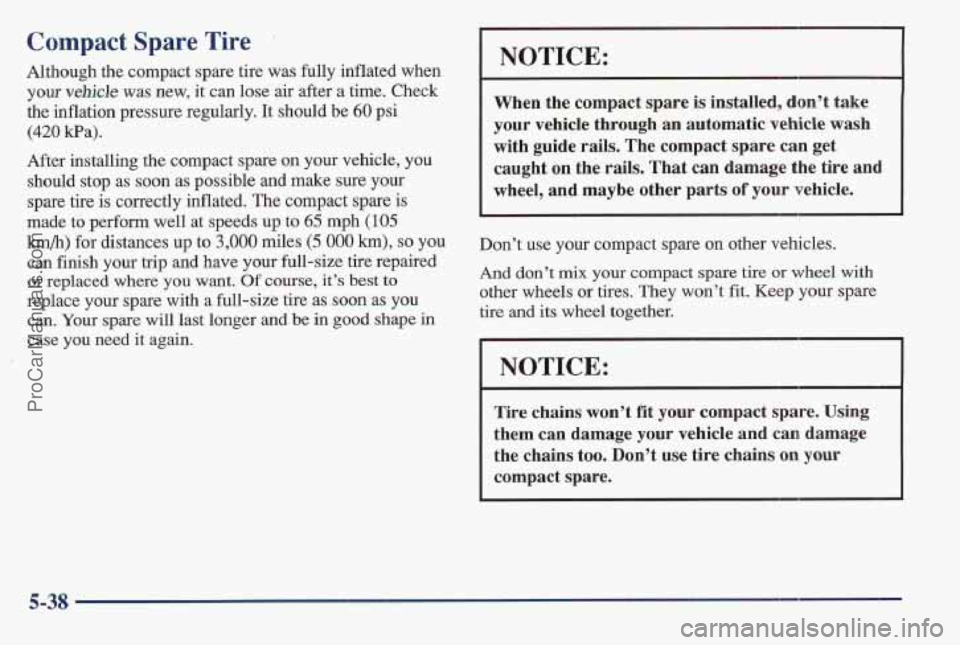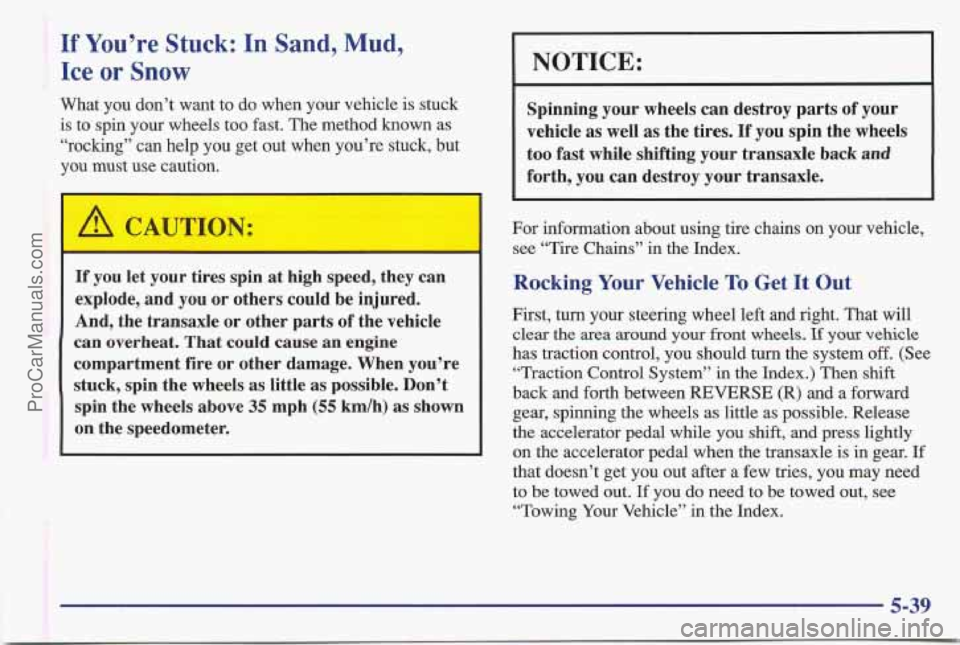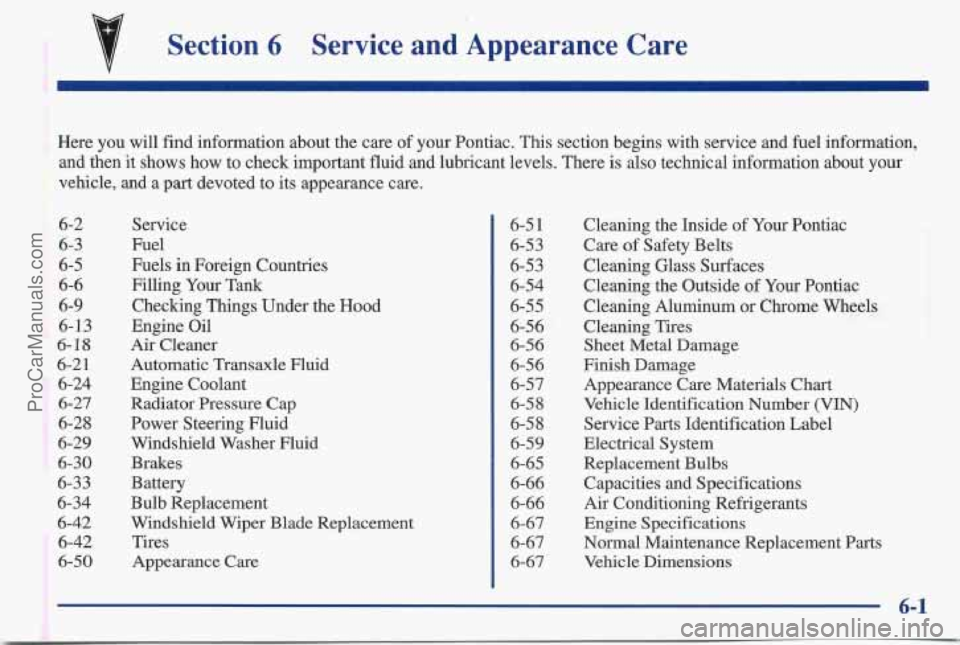Page 246 of 405
Never use oil or grease on studs or nuts. If you
do, the nuts might come loose. Your wheel could
fall off, causing a serious accident.
7. Replace the wheel nuts
with rounded end
of the
nuts toward the wheel. Make sure each wheel stud is centered in each
wheel hole while
tightening the nuts.
Tighten each nut by
hand until the wheel is
held against
the hub.
c
8. Lower the vehicle by rotating the wheel wrench
counterclockwise on the jack. Lower the
jack completely.
5-33
ProCarManuals.com
Page 247 of 405

9. Tighten the wheel
nuts firmly in a
criss-cross sequence.
Incorrect wheel nuts or improperly tightened
wheel nuts can cause the wheel
to become loose
and even
come off. This could lead to an accident.
Be sure
to use the correct wheel nuts. If you have
to replace them, be sure to get new
GM original
equipment wheel nuts.
Stop somewhere
as soon as you can and have the
nuts tightened with
a torque wrench to 100 Ib-ft
(140 N-m).
NOTICE:
~~~
Improperly tightened wheel nuts can lead to
brake pulsation and rotor damage. To avoid
expensive brake repairs, evenly tighten the wheel
nuts in the proper sequence and to the proper
torque specification.
Don’t try to put the wheel cover
on the compact
spare tire. It won’t fit. Store the wheel cover in the
trunk until you have replaced the compact spare tire
with a regular tire.
Wheel covers won’t fit
on your compact spare. If
you try to put a wheel cover on your compact
spare, you could damage the cover or the spare.
When
you re-install the full size wheel and tire, you
install the wheel cover or nut caps at this point.
5-34
ProCarManuals.com
Page 248 of 405
When re-installing the full plastic wheel cover,
align the valve stem
symbol (which is
molded into the back
side
of the cover) with
the valve stem. When re-installing the
decorative nut caps on
aluminum wheels,
tighten the caps snug
with the wheel wrench.
Start the nut cap by pushing it onto the lug nut with
the wheel wrench. Tighten the plastic caps snug
using the wheel wrench,. Then continue tightening
one-quarter
turn. Do not over-tighten. Then
continue tightening one-quarter turn for
plastic caps, or one-eighth turn for steel caps.
Do not over-tighten.
When re-installing
the center cover, do not use a
hammer or mallet, as they could damage the cover.
5-35
ProCarManuals.com
Page 249 of 405
Storing the Flat Tire and Tools
L
Storing a jack, a tire or other equipment in the
passenger compartment of the vehicle could
,cause injury. In a sudden stop or collision, loose
equipment could strike somleone. Store all these
in the proper place.
I
After you’ve put the compact spare tire on your vehicle,
you’ll need to store the flat tire in your trunk. Use the
following procedure to secure the flat tire in the trunk.
Store the flat tire as far forward in the trunk as possible.
Store the jack and wheel wrench in their box in the trunk
on the passenger’s side.
5-36
ProCarManuals.com
Page 250 of 405
Storing the Spare Tire and Tools
I A CAUTION:
I-.
Storing a jack, a tire or other equipment in the
passenger compartment
of the vehicle could
cause injury. In a sudden
stop or collision, loose
equipment could strike someone. Store all these
in the proper place.
The compact spare is for temporary use only. Replace
the compact spare tire with
a full-size tire as soon as you
can. See “Compact Spare Tire” later in this section. See
the storing instructions label to replace your compact
spare into your trunk properly.
5
4
3
1 2
1. Jack
2. Wheel Wrench
3. Wing Bolt
4. Tire
5. Cover
6. Bolt
5-37
ProCarManuals.com
Page 251 of 405

Compact Spare Tire
Although the compact spare tire was fully inflated when
your vehicle was new, it can lose air after a time. Check
the inflation pressure regularly.
It should be 610 psi
(420 Wa).
After installing the compact spare on your vehicle, you
should stop as soon
as possible and make sure your
spare tire
is correctly inflated. The compact spare is
made to perform well at speeds up to 65 mph (105
km/h) for distances up to 3,000 miles (5 000 km), so you
can finish your trip and have your full-size tire repaired
or replaced where you want. Of course, it’s best to
replace your spare with a full-size tire as soon as you
can. Your spare will last longer and
be in good shape in
case you need it again.
NOTICE:
When the compact spare is installed, don’t take
your vehicle through an automatic vehicle wash
with guide rails. The compact spare can get
caught
on the rails. That can damage the tire and
wheel, and maybe other parts of your vehicle.
Don’t use your compact spare on other vehicles.
And don’t mix your compact spare tire or wheel with
other wheels OF tires, They won’t fit. Keep your spare
tire and its wheel together.
NOTICE:
Tire chains won’t fit your compact spare. Using
them can damage your vehicle and can damage
the chains too. Don’t
use tire chains on your
compact spare.
5-38
ProCarManuals.com
Page 252 of 405

If You’re Stuck: In Sand, Mud,
Ice
or Snow
What you don’t want to do when your vehicle is stuck
is to spin your wheels too fast. The method known as
“rocking” can help you get out when you’re stuck, but
you must use caution.
c --
/L CAUTION:
1
If you let your tires spin at high speed, they can
explode, and you or others could be injured.
And, the transaxle or other parts of the vehicle
can overheat. That could cause an engine
compartment fire or other damage. When you’re
stuck, spin the wheels as little as possible. Don’t
spin the wheels above
35 mph (55 km/h) as shown
on the speedometer.
1 NOTICE: I
Spinning your wheels can destroy parts of your
vehicle
as well as the tires. If you spin the wheels
too fast while shifting your transaxle back
and
forth, you can destroy your transaxle.
For information about using tire chains on your vehicle,
see
“Tire Chains” in the Index.
Rocking Your Vehicle To Get It Out
First, turn your steering wheel left and right. That will
clear
the area around your front wheels. If your vehicle
has traction control, you should turn the system off. (See
“Traction Control System” in the Index.) Then shift
back and forth between
REVERSE (R) and a forward
gear, spinning the wheels as little as possible. Release
the accelerator pedal while you shift, and press lightly
on the accelerator pedal when the transaxle is in gear. If
that doesn’t get you out after a few tries, you may need
to be towed out. If you do need to be towed out, see
“Towing Your Vehicle” in the Index.
5-39
ProCarManuals.com
Page 254 of 405

v Section 6 Service and Appearance Care
Here you will find information about the care of your Pontiac. This section begins with service and fuel information,
and then it shows how to check important fluid and lubricant levels. There is also technical information about your
vehicle, and a
part devoted to its appearance care.
6-2
6-3
6-5
6-6
6-9
6-13
6-18
6-2 1
6-24
6-27
6-28
6-29
6-30
6-33
6-34
6-42
6-42
6-50 Service
Fuel
Fuels in Foreign Countries
Filling Your Tank
Checking Things Under the Hood
Engine Oil
Air Cleaner
Automatic Transaxle Fluid
Engine Coolant
Radiator Pressure Cap
Power Steering Fluid
Windshield Washer Fluid
Brakes
Battery
Bulb Replacement
Windshield Wiper Blade Replacement
Tires
Appearance
Care
6-5 1
6-53
6-53
6-54
6-55
6-56
6-56
6-56
6-57 6-58
6-58
6-59
6-65
6-66
6-66
6-67
6-67
6-67 Cleaning the Inside
of
Your Pontiac
Care
of Safety Belts
Cleaning Glass Surfaces Cleaning the Outside of Your Pontiac
Cleaning Aluminum
or Chrome Wheels
Cleaning Tires Sheet Metal Damage
Finish Damage
Appearance Care Materials Chart
Vehicle Identification Number (VIN)
Service Parts Identification Label
Electrical System
Replacement Bulbs
Capacities and Specifications
Air Conditioning Refrigerants
Engine Specifications
Normal Maintenance Replacement Parts
Vehicle Dimensions
ProCarManuals.com